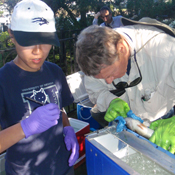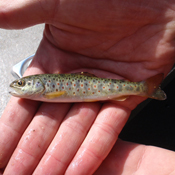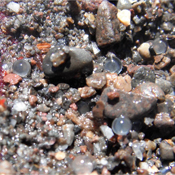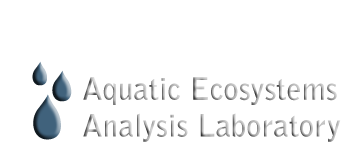Nearshore Indicators for Clarity, Habitat and Ecological Sustainsbility in Lake Tahoe

Project Overview
Lake Tahoe’s fishery is among one of the least studied of all the large lakes in the world. Over time there have been a variety of stressors (e.g. introduction of species, eutrophication, nearshore habitat modification), which may have impacted the fishery and only a limited amount of snapshot investigations have been conducted to investigate these impacts or determine the status of a particular species. With little to no information on the status of Tahoe’s fishery, in particular the nearshore components where most of the native, littoral fish reside, we have compiled information to determine the status of the nearshore native and non-native fish community and if there are quantifiable indicators and methodologies that can be created to determine the condition of the nearshore fishery. Traditional indicators (e.g. species composition, density, growth, condition, and spawning potential) were examined using historical (1960, 1990, etc) and contemporary (2008-2010) data to detect mid and long-term changes in Lake Tahoe nearshore fishery. The potential application of two novel indicators (trophic niche and UV) to measure long- and short-term changes in nearshore fishery was also examined. Experiments were conducted by our collaborators from Maimi University Ohio (Dr. Craig Williamson, Dr. Jim Oris, Dr. Andrew Tucker, and Amanda Gevertz) to determine if ultraviolet radiation (UV) can be used to link nearshore and non-native fish ecology to the physical environment.

Summary of Results
In 1991-1994 and 2008-2009, the predominant fish species caught in the nearshore minnow traps were Lahontan reside shiners (Richardsonius egregious) and speckled dace (Rhinichthys osculus robustus). However, current catch of these and other species have declined. Overall, nearshore fish densities have undergone general decrease (58 % of historically sampled sites) between 1988-89 and 2009. Lahontan reside shiners are found to be consuming a wider range of food types and relying more on surface food sources than before. These changes may be due to nearshore habitat modifications, which alter the food availability or clarity. Alternatively, predation from game fish (e.g. lake trout) may also contribute to the decline when native fishes move offshore in the winter. Changes in spawning activities (spawning behavior and egg presence) and condition of spawning habitats (substrate types) were observed in 30% (6/20) of the sites when compared to historical data collected by Allen and Reuter (1996). Changes observed can potentially be attributed to changes in substrate types at various spawning sites as a result of decrease in lake water levels.
Changes in trophic niche were found. All fish species examined, except Tahoe sucker (Catostomus tahoensis) demonstrated greater reliance in pelagic food source and all fish species have reduced trophic position. UV exposure and in situ incubation experiments show that UV transparency of nearshore sites significantly impacts the survival of warmwater fish larvae and influences whether these potentially invasive fish species are able to establish in nearshore Lake Tahoe. Native fish larvae (Lahontan redside shiner) were at least six times more tolerant of UV exposure than non-native warmwater fish larvae (bluegill and largemouth bass). Measurements of UV transparency around the lake showed that more than half of the sites sampled were in non-attainment, suggesting the potential for widespread warmwater fish establishment.
Our contemporary assessment suggests that the health of Lake Tahoe’s nearshore native fishery is deteriorating. Given potential expansion of suitable habitat for non-native fishes as a result of increasing spread of invasive plants, elevated lake water temperature, and reduction in UV transparency, as well as other related threats (e.g. nearshore development), the future of Lake Tahoe’s nearshore native fishery may be in trouble. We believe that a long-term nearshore monitoring and warmwater fish prevention program utilizing ecologically relevant metrics is necessary to help us better understand Lake Tahoe’s nearshore native fishery, and assist stakeholders to more effectively manage and restore the lake’s precious native biodiversity.
Project Photos

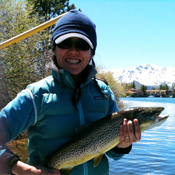
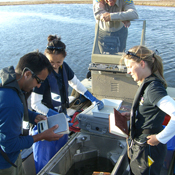
_th.jpg)
